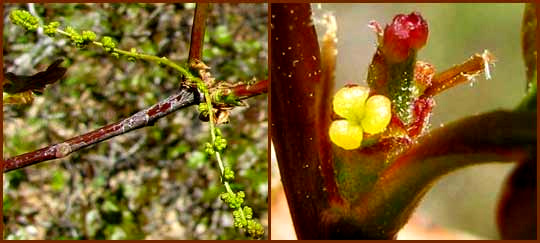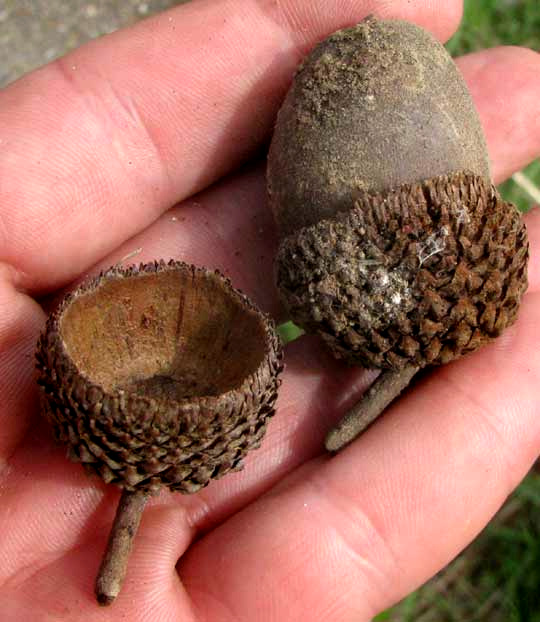
Oak trees bear male flowers on one part of their branch, and female flowers on another. The picture's inset at the bottom right shows an almost hidden female flower arising in a leaf's axis -- where the leaf's petiole connects with the stem. When a plant bears both male and female flowers it's said to monoecious.
The photo shows a flowering branch of a Black Oak, Quercus velutina, from a tree in Mississippi. It was photographed in mid March just as both the tree's leaves and flowers were appearing. The leaves in the picture are only about one-fifth their summer size.
Such an arrangement with unisexual flowers is very unlike our Standard Blossom, so it's a special feature to explore. Below is another look at an oak's male and female flowers, this time on the Brewer's Oak, Quercus garryana var. breweri on a slope of the Siskiyou Mountains in southern Oregon.

Notice that in both cases, as typical of oaks, the male flowers are arranged in long, slender, yellowish, wormlike items called catkins or, more technically, aments. Each of the "bumps" on the catkins is a male flower consisting of a bract (a highly modified leaf), a lobed calyx and some pollen-producing stamens. Once the stamens have released their pollen into the air, the entire catkin falls from the tree, maybe creating an impressive litter beneath the tree. Other kinds of trees producing catkins include willows and birch.

At the left in the above photo, one female flower's three yellow stigmas, or style branches with stigmatic surfaces, is especially noticeable, at the peak of pollen receptivity. Not all female oak flowers reside so snugly in leaf axils. The female flowers at the right, belonging to a Texas Live Oak, Quercus fusiformis, in Texas, are stalked. Notice that the flowers' ovaries -- the green bulges immediately beneath the stigmas -- arise from cuplike structures known as cupules. Cupules are the beginning of the future scaly, bowl-like cup that will hold the mature oak nut, or acorn.

At the left you see the scaly cups that will develop from these tiny cupules. The acorn has fallen from the cup on the left. These were found beneath a Swamp Chestnut Oak, Quercus michauxii, in Louisiana.

As acorns go, those of Swamp Chestnut Oaks are fairly large. However, at the right, look at the enormous acorns -- not even mature yet -- on a Burr Oak, Quercus macrocarpa, in Texas.
Oak species fall into two great natural groups.
- In the White Oak Group, acorns mature during same season as their flowers. Their acorns are realtively sweetish and edible, at least with a little preparation. The Chestnut Oaks belong to this group.
- In the Red and Black Oak Group, acorns mature in their second year. Their flesh normally is much more bitter and harder to eat.